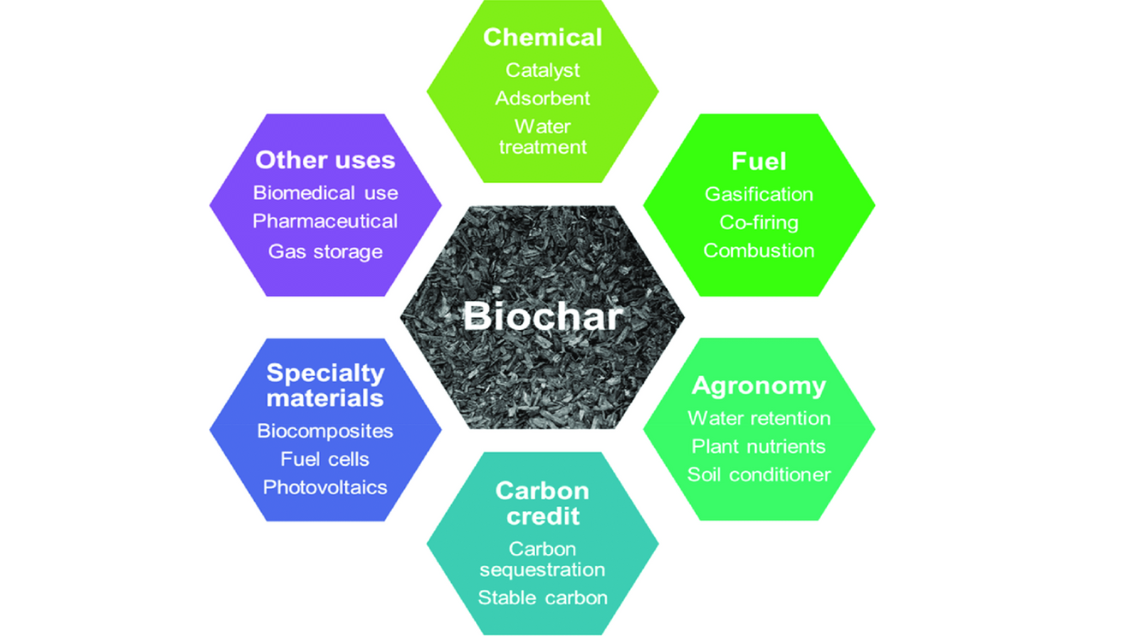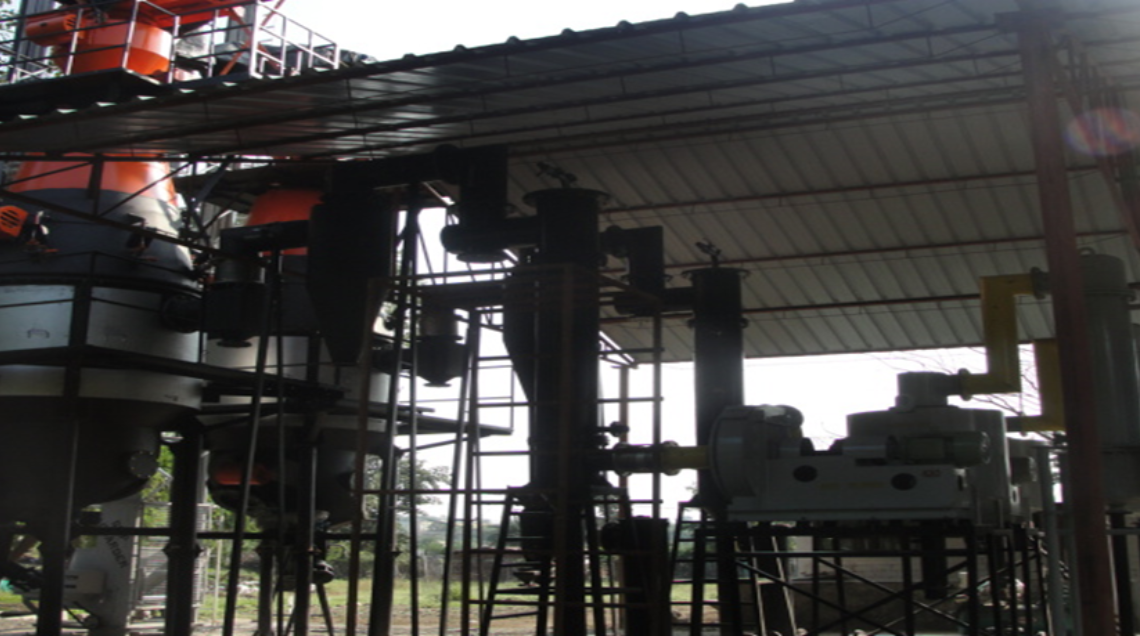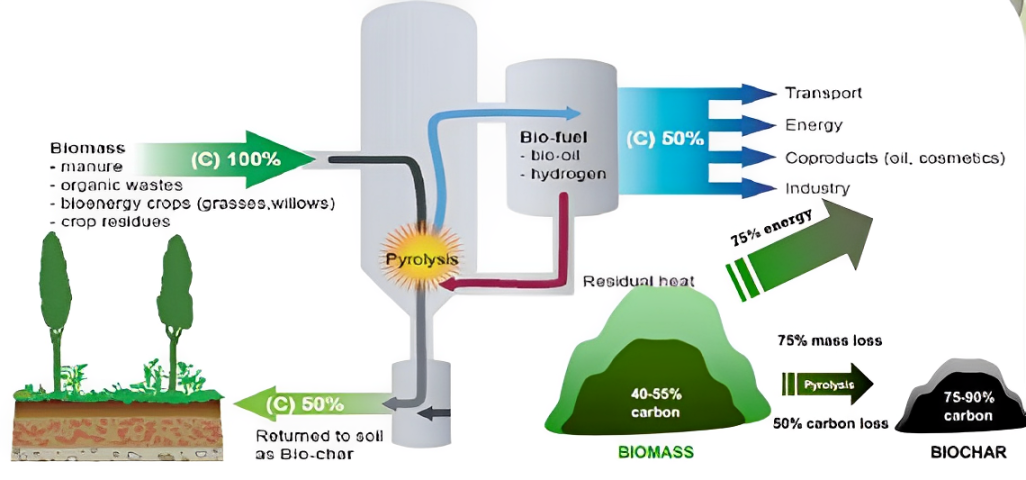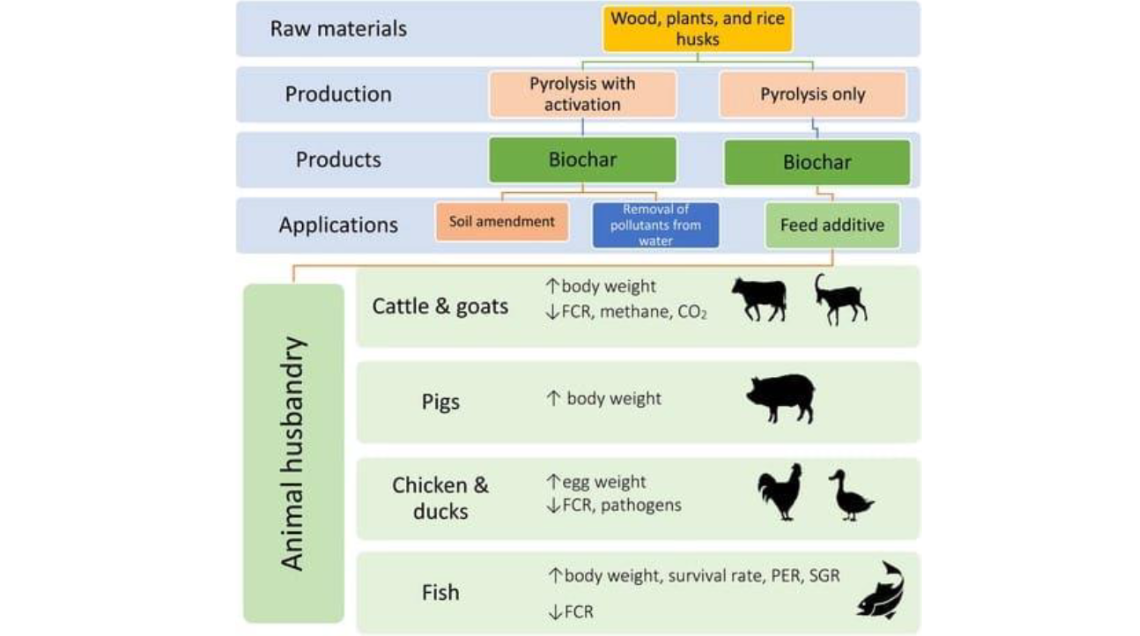What is Biochar?
Biochar is a carbon-rich, fine-grained residue which can be produced either by ancient techniques (such as covering burning biomass with soil and allowing it to smoulder) or state-of-the-art modern biomass gasification / pyrolysis processes. Combustion and decomposition of woody biomass and agricultural residues results in the emission of a large amount of carbon dioxide, where as Gasification / pyrolysis of such biomass would convert it to Biochar which when applied to soil can store this CO2 in the soil leading to reduction in GHGs emission and enhancement of soil fertility.

Manufacturing of Biochar
Biochar is produced by heating biomass in the total or partial absence of oxygen. Pyrolysis is the most common technology employed to produce biochar, and also occurs in the early stages of the combustion and gasification processes. Besides biochar, bio-oil and gas can be collected from modern pyrolysers. The pyrolysis gas is mainly a mixture of carbon monoxide (CO) and hydrogen (H2) with lower quantities of CO2, CH4, H2O, and a range of volatile compounds.
In our unit we use bamboo obtained as waste material from various processing as shown in our flow chart. This waste then fed into the biomass gasifiers, under controlled conditions and in absence of oxygen the process of manufacturing of biochar takes place. This process produces gas and charcoal, this obtained gas is called producer gas and can be use for thermal or electrical application.


Benefits of Making Bamboo Biochar
While the forest coverage in tropical and subtropical is decreasing, the bamboo forest area is increasing. It is estimated that the Bamboo area is increased annually by 1-2% per in the world and 2-3% in China. The reasons behind this phenomena are :
- Easy to be managed, high biomass production.
- High economic value: Bamboo timber can be harvested every year after 4-5 years, compared to 20 to 50 years for trees.
- Bamboo can be selectively harvested annually and regenerates without replanting.
- Bamboo generates 30% more oxygen than trees.
- Helps reduce carbon dioxide gases blamed for global warming; some bamboo sequesters up to 12 tons of carbon dioxide per hectare, making it an efficient replenisher of fresh air.
- Bamboo biochar can increase the amount of carbon locked into the soil for hundreds or thousands of years.
- Biochar helps soil retain water and reduces methane and nitrogen emissions.
- Biochar is a carbon-rich product made from renewable agricultural/woody biomass waste residue like bamboo, corn cobs, cotton stalk, lantana, and mulberry.
- Produced through gasification of bamboo waste (heating in the absence of oxygen).
- Can be used either alone or mixed with organic additives in a suitable ratio.
- Research and field experience show an increase in crop yields by using Biochar Soil Amendment.
- Biochar has tremendous potential for water conservation in agriculture and horticulture, especially in poly houses/greenhouses and new plantations.
- Very useful in areas where water is scarce and soil is degraded.
- A soil amendment that is plowed-in only once and has a lasting effect for centuries.
Applications of Biochar
Biochar as an agent for soil amendment
- Repairs degraded soils and resists soil erosion.
- Increases yield by 5 - 40%.
- Enhances soil biology (40% increase in mycorrhizal fungi) and improves nutrient retention in soils (50% increase in Cation Exchange Capacity).
- Improves the water retention capacity of soils (up to 20% increase), thus effectively reducing water required for irrigating the soil for crop production.
- Increases soil organic matter.
- Facilitates reduction of the need for chemical fertilizer, thus further reducing water pumping for irrigation.
- Improves soil drainage and facilitates a more neutral pH.
- Reduces soil compaction and increases nutrient cycling.
- Greater retention of water in dry soils improves germination.
- Improves plant resistance to fungal diseases, root-feeding nematodes, and insect infestations.
| Factor | Impact | Source |
|---|---|---|
| Cation exchange capacity | 50% increase | (Glaser et al., 2002) |
| Fertilizer use efficiency | 10-30% increase | (Gaunt and Cowie, 2009) |
| Liming agent | 1 point pH increase | (Lehman and Rondon, 2006) |
| Soil moisture retention | Up to 18% increase | (Tryon, 1948) |
| Crop productivity | 20-120% increase | (Lehman and Rondon, 2006) |
| Methane emission | 100% decrease | (Rondon et al, 2005) |
| Nitrous oxide emissions | 50% decrease | (Yanai et al., 2007) |
| Bulk density | Soil dependent | (Laird, 2008) |
| Mycorrhizal fungi | 40% increase | (Warnock et al., 2007) |
| Biological nitrogen fixation | 50-72% increase | (Lehman and Rondon, 2006) |

Biochar as an agent for climate change mitigation
Decaying or burning biomass releases CO2 into the atmosphere and plants reabsorb it; this active carbon cycle has been in balance for millennia. Burning fossil fuels puts excessive CO2 into the air, more than can be absorbed naturally. This traps heat in the Earth’s atmosphere. Reducing atmospheric CO2 is critical to combat climate change. Large amounts of forestry and agricultural residues and other biomass are currently burned or left to decompose thereby releasing carbon dioxide (CO2) and/or methane (CH4)—two main greenhouse gases (GHGs)—into the atmosphere. Under biochar conversion scenarios, easily mineralized carbon compounds in biomass are converted into fused carbon ring structures in biochar and placed in soils where they persist for hundreds or thousands of years. When deployed on a global scale through the conversion of gigatons of biomass into biochar, studies have shown that biochar has the potential to mitigate global climate change by drawing down atmospheric GHG concentrations.
Biochar in animal farming
At present approx. 90% of the biochar used in Europe goes into animal farming. Different to its application to fields, a farmer will notice its effects within a few days. Whether used in feeding, litter or in slurry treatment, a farmer will quickly notice less smell. Used as a feed supplement, the incidence of diarrhoea rapidly decreases, feed intake is improved, allergies disappear, and the animals become calmer.
In Germany, researchers conducted a controlled experiment in a dairy that was experiencing a number of common health problems: reduced performance, movement disorder, fertility disorders, inflammation of the urinary bladder, viscous salivas, and diarrhoea. Animals were fed different combinations of charcoal, sauerkraut juice or humic acids over periods of 4 to 6 weeks.
- Biochar has been used in acute medical treatment of animals for many centuries. Since 2010, livestock farmers increasingly use biochar as a regular feed supplement to improve animal health, increase nutrient intake efficiency, and thus productivity.
- Studies on beef cows in the Great Plains of the US found that adding biochar to feed reduces cows' methane emissions by 9.5%.
- The use of biochar as a feed additive has the potential to improve animal health, feed efficiency, and the animal-stable environment while reducing nutrient losses.
- Oral applications of biochar from 200-400 g/day have proved beneficial.

Improved Digestion: Biochar has been shown to promote improved digestion in animals.
Increased Immunity: As an adsorbent, biochar has been shown to lock up toxins in the digestive tract. This maintains the balance of microbial activity and avoids subsequent damage to the animal’s digestive system.
Reduced Chronic Botulism: Botulism in cows has been an increasing concern in recent years.
Increased Feed and Energy Efficiency: The addition of biochar to poultry feed has been shown to improve the absorption of energy from feed, ultimately improving the efficiency of the feed.
Increased Growth Rates: Increased growth rates and final body weights in broilers as a result of biochar have also been documented.
Biochar in Poultry: An immediate use of biochar in poultry farming is to reduce and even eliminate odours from poultry litter, particularly ammonia.
Biochar adsorbs gases, liquids, and ions, and ammonia (NH4+) is all three. Ammonia irritates skin on contact and degrades even hard tissue, such as hooves. It also attracts insects, such as flies. This is one reason biochar can even serve as a fly deterrent.
Biochar is also a catalyst to facilitate populations of microbes. Many bacteria, fungi, and other simple life forms take up residence in char micropores. Feeding biochar stimulates beneficial bacteria in the GI tract to strengthen digestion and immunity. It can increase nutrient adsorption, retention, and transport to improve the liver-intestine circuit.
Biochar promotes digestion and improves feed efficiency, thus increasing energy gained from feed. Toxins effectively bind to biochar, mitigating adverse effects on the digestive system and intestinal flora. The health and vitality of animals also improve, as will meat and egg production. With animals’ immune systems stabilized, infection risks from pathogens decrease.
Biochar as construction material
- The two interesting properties of biochar are its extremely low thermal conductivity and its ability to absorb water up to 6 times its weight. These properties mean that biochar is just the right material for insulating buildings and regulating humidity. In combination with clay, but also with lime and cement mortar, biochar can be added to clay at a ratio of up to 50% and replace sand in lime and cement mortars. This creates indoor plasters with excellent insulation and breathing properties, able to maintain humidity levels in a room at 45–70% in both summer and winter. This in turn prevents not just dry air, which can lead to respiratory disorders and allergies, but also dampness and air condensing on the walls, which can lead to mould developing.
- The biochar-mud plaster adsorbs smells and toxins, a property not just benefiting smokers. Biochar-mud plasters can improve working conditions in libraries, schools, warehouses, factories and agricultural buildings.
- Biochar is an efficient adsorber of electromagnetic radiation, meaning that biochar-mud plaster can prevent ―electrosmog‖. Biochar can also be applied to the outside walls of a building by jet-spray technique mixing it with lime. Applied at thicknesses of up to 20 cm, it is a substitute for Styrofoam insulation. Houses insulated this way become carbon sinks, while at the same time having a more healthy indoor climate. Should such a house be demolished at a later date, the biochar-mud or biochar-lime plaster can be recycled as a valuable compost additive.
Use of Biochar as a Decontaminant
- As a soil additive for soil remediation – for use in particular on former mine-works, military bases, and landfill sites.
- Soil substrates – Highly adsorbing and effective for plantation soil substrates for use in cleaning wastewater; in particular, urban wastewater contaminated by heavy metals.
- A barrier preventing pesticides from getting into surface water – berms around fields and ponds can be equipped with 30-50 cm deep barriers made of biochar for filtering out pesticides.
- Treating pond and lake water – biochar is good for adsorbing pesticides and fertilizers, as well as for improving water aeration.
Use of Biochar in Wastewater Treatment
- Biofiltration of the municipal wastewater with biochar acting as the bio adsorbent allowed to take place over a 5-day period will reduce COD concentration in the municipal wastewater by 90% upon treatment with biochar.
Use of Biochar in Textiles
- In Japan and China, bamboo-based biochars are already being woven into textiles to gain better thermal and breathing properties and to reduce the development of odors through sweat. The same aim is pursued through the inclusion of biochar in shoe soles and socks.
Get In Touch


